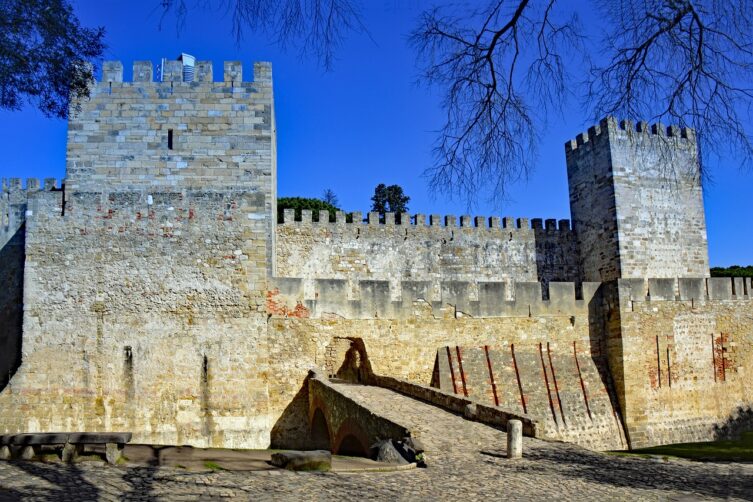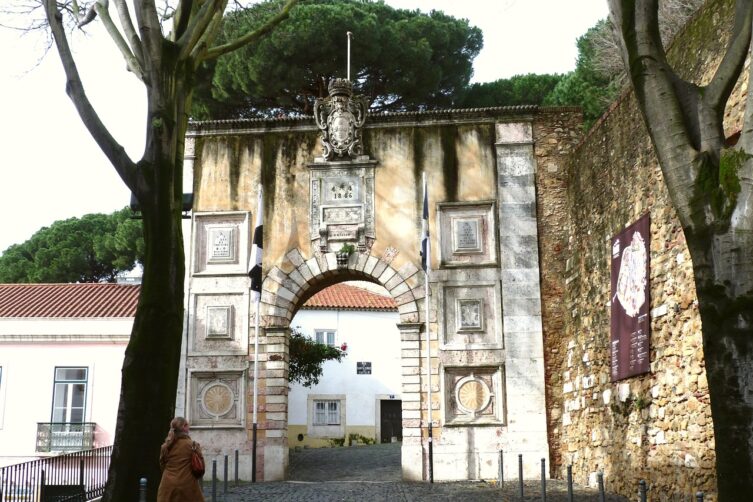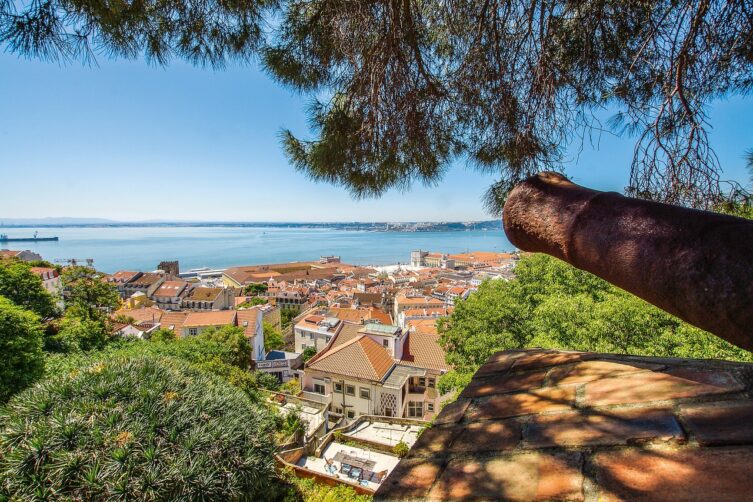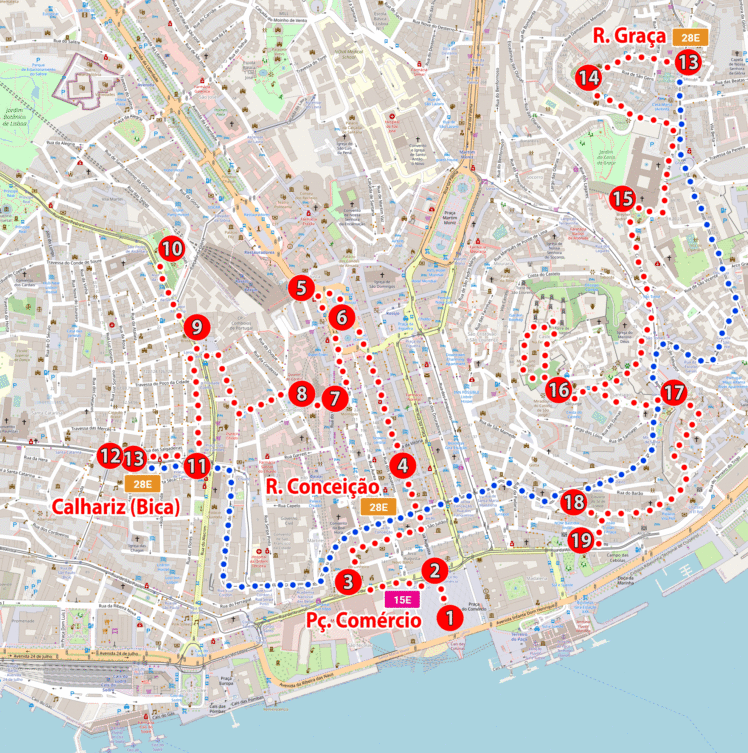St. George in Lisbon - sightseeing, interesting facts, tickets, map

Olysipum
St. George's Castle (Sao Jorge's Castle) can be seen from virtually anywhere in Lisbon. Vast buildings, spreading almost over the entire hill, have been towering over the city for over 1000 years. The walls that we can admire here today were built in XNUMXth centuryraised by hands Moors. The Moors, after conquering the city, decided to fortify it strongly to facilitate their undivided and long control over this area. They knew the history of this place and would not want it to repeat itself. Olysipum (because that was the name of the city before the Moors who came from North Africa conquered it in the XNUMXth century), without proper fortifications, it was an easy target. This is probably why it changed hands so often.

The first Celts who were present here lost their territory to the Phoenicians. Then came the Greeks, then the Carthaginians, and then (in the XNUMXst century BC) the Romans. The latter decided to erect the first fortifications, but they were not very impressive. So they lost the city to the Suebi (one of the Germanic tribes), and these, in turn, had to recognize the advantage of the Visigoths a little later. Then the Moors appeared. They took Olisipo, gave it a new name Lishubna and in the XNUMXth century they started building a castle and defensive walls. It was then that the castle and the fortifications forming a closed ring were built, now known as Hearts of Moura (free translation: Ring of the Moors).
Lishubna
The reign of the Moors lasted for about 400 years (from the 1147th to the XNUMXth centuries). It ended in XNUMX when Lisbon was conquered by the Portuguese king Alphonsus I the Conqueror.
However, conquering the city was not so easy. Alphonsus I would not have been able to deal with this alone. He cleverly took advantage of the unique opportunity that presented him.
The greatest powers of Europe at that time, by preparing the second Crusade, created a common army. It consisted of a total of 13 Flemish, Frisian, Norman, English, Scottish and German crusaders. On the way from England to the Holy Land, the shipping army stopped on the coast near Lisbon and lent support to Alfonso I.
13 crusaders and 000 soldiers of Alfonso I began to storm the city. The Moors were ousted and Lisbon was conquered. As it turned out later, the unplanned conquest of Lisbon was the greatest success of the Second Crusade. After reaching the Holy Land, the crusade had no success and was a complete failure.

source: Wikipedia under the public domain
The new capital of Portugal
One hundred years later, the Portuguese capital moved from Coimbra to Lisbon, and the castle became a citadel and became the seat of Alfonso III. Over time, it was rebuilt on Royal Defense Palace but the changes did not end there. In 1375, thanks to the actions of King Ferdinand I, the castle and the city gained new, important fortifications. The king ordered construction the second, this time much wider ring of fortifications, also covering a large part of the city. In just two years it was built Cerca Nova (New Ring), also called Cerca Fernandina (Ferdinand's Ring). The previously unprotected parts of the city were sheltered by solid fortifications, consisting of a wall with a length of 5,4 km, equipped with 77 towers and 46 gates.
Some gates and fragments of walls have survived to this day in the form of more or less damaged ruins.
Curiosity:
Based on the materials available on the Internet, I was able to prepare a map showing the course of the fortifications and put it on the map of the route of our trip. Perhaps while walking around Lisbon you will accidentally stumble upon preserved fragments of fortifications.
The map below shows two color-marked areas:
- red area - is an area of fortifications built by the Moors, i.e. Ring of the Moors (Cerca Moura)
- green area – is an area covered by fortifications built on the order of King Ferdinand I, i.e. Cerca Nova (The New Ring), also called Cerca Fernandina (Ferdinand's Ring)

- red area: Ring of the Moors
- green area: New Ring
Twilight of splendor
When, at the request of Manuel I the Happy, it was built on the banks of the Tagus River Ribeira Palace, the king moved to him along with the entire court and the importance of the castle drastically decreased. The castle fell to the margins of events and slowly fell into ever deeper neglect. His situation worsened even more during the 1531 earthquake.
A brief hope of restoring splendor appeared during the reign of King Sebastian I, who commissioned the reconstruction of the castle, intending to use it as his official residence. According to the planned changes, one tower was demolished, but shortly thereafter, King Sebastian I suddenly disappeared without a trace. His fate has not been clarified until today. The most likely version of the events assumes that he died unnoticed in action during the Battle of Alcácer Quibir. The disappearance of the king meant that the reconstruction of the castle was not completed and only contributed to the deepening of the ruin of the building.
In 1755, another, even bigger, earthquake came. The castle suffered but did not collapse. However, the Ribeir Palace was completely destroyed, which took the palm of the priority from the castle for two hundred years. The palace was not suitable for reconstruction and was eventually razed to the ground. And the castle? The castle remained and persistently defended its position on the hill for the next 200 years. He stubbornly kept on fighting the last of his strength with the passing of time and the lack of interest until the XNUMXth century.

Regained dignity
The XNUMXth century brought a breakthrough. The castle has undergone several renovations that have brought it to a state it has not been in for centuries. Today it happily pleases our eyes, proudly towering over Lisbon.
Despite unfavorable circumstances, it survived two major earthquakes and hundreds of years of unfavorable fate, remaining one of the oldest witnesses to the centuries-old history of the city. It has regained the respect it deserves and is enjoying the well-deserved interest of tourists.

Useful data
St. George, GPS coordinates:
38°42’44.3″N 9°07’58.9″W
38.712317, -9.133013 - click and route
Entrance to St. George, GPS coordinates:
38°42’45.3″N 9°07’59.5″W
38.712580, -9.133202 - click and route
You can buy tickets to the castle directly on the castle page - [click]. If you have a card Lisboa Card it is possible that you will be entitled to a ticket discount, but it cannot be used when buying a ticket online. The discount (if available) can only be used when buying tickets at the castle box office (recently it was a discount from EUR 10 to EUR 6 for an adult ticket).

number 16 is the castle of St. George
Lisbon sightseeing itinerary
This post is part of a very detailed Lisbon sightseeing itinerary that I have developed. The plan is available for free and you can see it on the website: Lisbon sightseeing plan - map, attractions, monuments, tickets, accommodation, interesting factsAccommodation in Lisbon
To facilitate the search for accommodation, I will present here some interesting (in my opinion) proposals from the historic center of Lisbon (Alfama). Don't consider them "just the best". They are an interesting proposition and can be a good choice or a good starting point for further research. Clicking on any of these hotels will take you to the offer details and (perhaps even more importantly) will display a list of similar offers. Thanks to this, you will immediately gain access to a list of interesting accommodation, which you can then filter and view according to your preferences.
Cozy Alfama - [click]
Alfama - [click]
Alfama - Lisbon Lounge Suites - [click]
Portugal sightseeing plan
This entry is part of a complete one Portugal sightseeing plan - [click]. The guide contains plans, maps and descriptions of specific sightseeing routes.To see all currently available descriptions of attractions in Portugal, click on the link: Continental Portugal - [click].
Safe car rental guide: Portugal - car rental without credit card, no deposit
Important to me!
Give the article a good rating (5 stars welcome 😀)!It's free, a for me it is very important! The blog lives on visits and thus has a chance to develop. Please do it and ... thank you in advance!
If you like my guides, you will certainly find the one I created useful guide catalog - [click]. There you will find ready-made ideas for your next trips, descriptions of other tourist destinations and an alphabetical list of guides divided into countries, cities, islands and geographical regions.
I also post link to Facebook profile - [click]. Come in and press "Follow"then you will not miss new, inspiring posts.
Unless you prefer Instagram. I'm not a social media demon, but you can always count on something nice to look at on my instagram profile - [click]. The profile will gladly accept any follower who likes it.
I make the content I create available free of charge with copyright, and the blog survives from advertising and affiliate cooperation. So, automatic ads will be displayed in the content of the articles, and some links are affiliate links. This has no effect on the final price of the service or product, but I may earn a commission for displaying ads or following certain links. I only recommend services and products that I find good and helpful. Since the beginning of the blog's existence, I have not published any sponsored article.
Some of the readers who found the information here very helpful, sometimes ask me how you can support the blog? I do not run fundraisers or support programs (type: patronite, zrzutka or "buy coffee"). The best way is to use links. It costs you nothing, and support for the blog is self-generating.
Pozdrawiam




I use the studies when traveling around Europe, I am very satisfied with them. I recommend it because it's a solid piece of work.